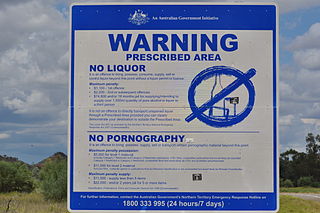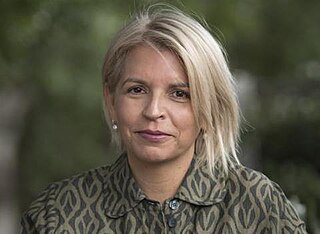
The Noongar are Aboriginal Australian people who live in the south-west corner of Western Australia, from Geraldton on the west coast to Esperance on the south coast. There are 14 different groups in the Noongar cultural bloc: Amangu, Ballardong, Yued, Kaneang, Koreng, Mineng, Njakinjaki, Njunga, Pibelmen, Pindjarup, Wadandi, Whadjuk, Wiilman and Wudjari. The Noongar people refer to their land as Noongar boodja.

Yagan was an Aboriginal Australian warrior from the Noongar people. Yagan was pursued by the local authorities after he killed Erin Entwhistle, a servant of farmer Archibald Butler. It was an act of retaliation after Thomas Smedley, another of Butler's servants, shot at a group of Noongar people stealing potatoes and fowls, killing one of them. The government offered a bounty for Yagan's capture, dead or alive, and a young settler, William Keats, shot and killed him. He is considered a legendary figure by the Noongar.

The Racial Discrimination Act 1975(Cth) is an Act of the Australian Parliament, which was enacted on 11 June 1975 and passed by the Whitlam government. The Act makes racial discrimination in certain contexts unlawful in Australia, and also overrides state and territory legislation to the extent of any inconsistency.
Human rights in Australia have largely been developed by the democratically elected Australian Parliament through laws in specific contexts and safeguarded by such institutions as the independent judiciary and the High Court, which implement common law, the Australian Constitution, and various other laws of Australia and its states and territories. Australia also has an independent statutory human rights body, the Australian Human Rights Commission, which investigates and conciliates complaints, and more generally promotes human rights through education, discussion and reporting.
Dean John Douglas Alston is an Australian cartoonist who became the editorial cartoonist of The West Australian newspaper in 1986.
Kenneth Desmond Colbung AM MBE, also known by his indigenous name Nundjan Djiridjarkan, was an Aboriginal Australian leader from the Noongar people who became prominent in the 1960s. He was appointed an MBE and an AM for his service to the Aboriginal community.
Robert Charles Bropho was a Ballardong Noongar Australian Aboriginal, rights activist and convicted serial child sex offender from Perth, Western Australia.

The Swan Valley Nyungah (Noongar) Community was an Aboriginal community of Noongar people at Lord Street, in the outer Perth suburbs of Lockridge and Eden Hill in Western Australia.
The Native Title Act 1993(Cth) is a law passed by the Australian Parliament, the purpose of which is "to provide a national system for the recognition and protection of native title and for its co-existence with the national land management system". The Act was passed by the Keating government following the High Court's decision in Mabo v Queensland (No 2) (1992). The Act commenced operation on 1 January 1994.
The Canadian Human Rights Commission (CHRC) was established in 1977 by the Government of Canada. It is empowered under the Canadian Human Rights Act to investigate and to try to settle complaints of discrimination in employment and in the provision of services within federal jurisdiction. The CHRC is also empowered under the Employment Equity Act to ensure that federally-regulated employers provide equal opportunities for four designated groups: women, Aboriginal people, the disabled, and visible minorities. One member of the Commission is designated as the Accessibility Commissioner under the Accessible Canada Act. The Commission helps enforce those human rights and inform the general public and employers of those rights.

Brandy v Human Rights and Equal Opportunity Commission (HREOC) was a case before the High Court of Australia determining that the HREOC could not validly exercise judicial power. The High Court maintained a firm position against attempts to confer judicial powers upon non-judicial bodies.

The Northern Territory National Emergency Response, also known as "The Intervention" or the Northern Territory Intervention, and sometimes the abbreviation "NTER" was a package of measures enforced by legislation affecting Indigenous Australians in the Northern Territory (NT) of Australia, which lasted from 2007 until 2012. The measures included restrictions on the consumption of alcohol and pornography, changes to welfare payments, and changes to the delivery and management of education, employment and health services in the Territory.

Silberberg v The Builders Collective of Australia Inc, is a 2007 judgment of the Federal Court of Australia, and the first Australian case exploring the liability of Internet forum operators for racial vilification under the Racial Discrimination Act 1975.
Media portrayals of Indigenous Australians have been described by academics and commentators as often negative or stereotyped. It is said that in issues which concern them, the voices of Indigenous Australians are drowned out by non-Indigenous voices, which present them as problems for the rest of society.
This is a timeline of Aboriginal history of Western Australia.
The hate speech laws in Australia give redress to someone who is the victim of discrimination, vilification or injury on grounds that differ from one jurisdiction to another. All Australian jurisdictions give redress when a person is victimised on account of skin colour, ethnicity, national origin or race. Some jurisdictions also give redress when a person is victimised on account of religion, disability, gender identity, HIV/AIDS status or sexual orientation.
Section 18C of the Racial Discrimination Act 1975, deals with offensive behaviour "because of race, colour or national or ethnic origin" in Australia. It is a section of the Racial Discrimination Act 1975, which was passed by the Australian Parliament during the term of the Whitlam government and makes racial discrimination unlawful in Australia. Section 18C was added by the Keating government in 1995. The Section has been controversial and subject to much debate.

Substantive equality is a substantive law on human rights that is concerned with equality of outcome for disadvantaged and marginalized people and groups and generally all subgroups in society. Scholars define substantive equality as an output or outcome of the policies, procedures, and practices used by nation states and private actors in addressing and preventing systemic discrimination.
Anti-discrimination laws in Australia have been enacted at both federal and state/territory levels to outlaw discrimination and harassment in a range of areas of public life. Federal law operate concurrently with state/territory laws, so both sets of laws must be followed.

Hannah McGlade CF is an Indigenous Australian academic, human rights advocate and lawyer. She is a Kurin Minang Noongar woman of the Bibulman nation and is as of May 2022 an associate professor at Curtin University's law school. She was appointed Senior Indigenous Fellow at the Office of the United Nations High Commissioner for Human Rights in 2016 and has been a member of the United Nations Permanent Forum on Indigenous Issues since 2020.







